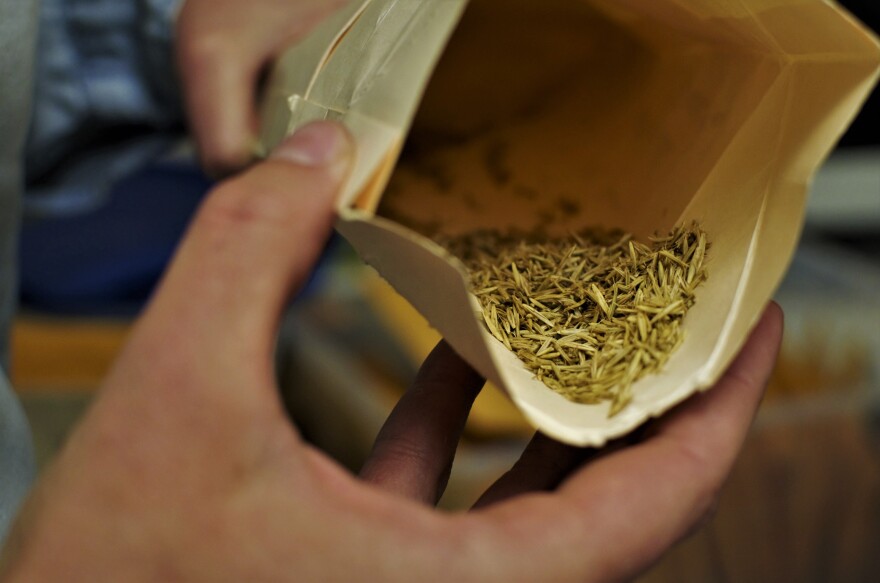A University of Nevada, Reno study has been looking into a new way to restore land that's been burned by wildfire to prevent the land from being charred again.

Alison Agneray is a PhD student at UNR. She spends her research time driving all across Northern Nevada, rummaging through fields and collecting seeds from native grasses and brushes by hand. She showed me some of them at a biology lab at UNR.
"This is the chaenactis douglasii," Agneray said. "These are very difficult to collect, but they are very beautiful in my opinion, so I have a lot of fun collecting these."
What she is doing with these seeds might seem pretty simple, but what Angeray is doing might end up being some of the most important work in preventing wildfire in Nevada.
Agneray and UNR Professor Beth Leger are partnering with the Bureau of Land Management to find the best seeds that will grow into full plants across the state to help restore public land that has been burned by wildfire.
"I hate to use this pun, but it's a grass-roots effort," Leger said.

80 percent of the land in Nevada is public and Leger said the BLM is in charge of restoring about 70 percent of it.
The problem the bureau faces is that this restored land keeps getting burned. Data from the BLM said the fires, despite years of research and land restoration, statistically keep getting bigger and bigger.
It's a problem that affects quite a few ranchers who use public lands for their animals to graze on. Rancher Gregg Simonds has nearly 11,000 animals graze on public lands near Battle Mountain.
"Since 1999, over 30 percent of it has burned twice," Simonds said. "And we've had up to five fires on the same site."
He's lost several animals due to these fires.
Ranchers like Simonds remain resilient. but their plight fuels researchers like Leger, who has been working to fix this problem for about a decade.
After a wildfire ravages public land, the BLM plants seeds over the area to restore the environment.
But Leger said a major issue is that those seeds are native to the West, but they're not really local to Nevada.
"These are 'natives,' but the source of the seeds that we're planting in Nevada is often very, very far from Nevada. Its original collection location is in Oregon or Washington," Leger said, "or sometimes even Canada."
Since these seeds come from areas that have more rain, the plants don't grow well here, if at all.
"That's not how nature works," Leger said. "Evolution shapes plant traits to match their environment and expecting a plant from at 25-inch [precipitation] zone to do okay in Tonopah is not really rational."
And the plants that do grow typically are annuals, which die after their first season.
"Annuals...they live fast, die young, produce a lot of litter, and catch on fire," Leger said.
And since these plants don't grow well here, it makes a lot of room for cheat grass.

"It just fills in all the space," said Lee Turner from the Nevada Department of Wildlife. "It's drier and more capable of supporting a fire."
Turner works with the BLM to restore land after wildfire. It's something he's done for two decades.
Turner, along with researchers from the BLM, said the massive amount of grass acts kind of like a fuse between bigger plants.
"It's perfect. It's perfect fuel," Turner said. "And then you get a windy day and a lightning strike and that turns out into [a 10,000-acre fire], and that turns into 100,000 acres in no time."
Fred Edwards is a regional coordinator for the BLM. He didn't speak on tape, but he said the problem is there hasn't been a lot of conclusive research into what kind of restorative plants grow well without agricultural assistance in the high desert.

Leger is continuing to explore that question, but she said the ideal seeds to plant in Nevada are going to be more expensive than the ones the BLM has planted in the past.
"But if you think about it in terms of price per success, it might end up being a better outcome," Leger said.
Another challenge to face is that the kind of place that produces these high-desert-specific seeds at a mass scale doesn't really exist at this point. Here's Lee Turner again.
"There's been a lot of discussion over the years about, 'How do we source?,'" Turner said. "'How do we get better at getting local seed sources?' People have been trying to get this moving, and it's sort of moved forward in fits and starts."
Both researchers said it's going to take another few years for this to be implemented full-scale because, well...the process is kind of like watching grass grow... because it actually is watching grass grow.






